Yves GARY Affichages : 3695
Catégorie : 1899 : DEFI N°10
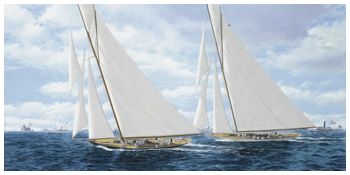 COLUMBIA LAISSE SHAMROCK DERRIÈRE
COLUMBIA LAISSE SHAMROCK DERRIÈRE 17 Oct. 1899 - (pas de traduction) After seven failures to accomplish the feat, the first of the series of races for the America's Cup was sailed yesterday.
17 Oct. 1899 - (pas de traduction) After seven failures to accomplish the feat, the first of the series of races for the America's Cup was sailed yesterday.
The result was that the American yacht crossed the finish line the victor by more than ten minutes. There was not much enthusiasm at the line, because from the start to the finish the race had been a procession, with Columbia constantly increasing a lead which she established soon after crossing the line at the beginning of the contest.
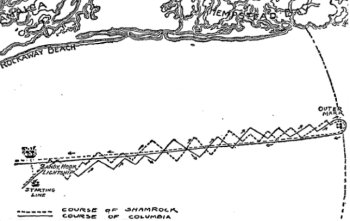 When old Sol climbed aloft in the heavens yesterday morning the blanket of sea fog that drifted in Sunday night was thicker and more dense than ever, and even the most enthusiastic yachtsmen predicted another failure. Not a breath of air was stirring, and the voices of the barkers for the various excursion steamers were as still and small as the conscience of a tugboat Captain.
When old Sol climbed aloft in the heavens yesterday morning the blanket of sea fog that drifted in Sunday night was thicker and more dense than ever, and even the most enthusiastic yachtsmen predicted another failure. Not a breath of air was stirring, and the voices of the barkers for the various excursion steamers were as still and small as the conscience of a tugboat Captain.
The few that did start were assured that there would be another failure, and even the experts who have predicted breezes from time to time declined to make another prophecy. A dozen craft managed to obtain sufficient passengers to make the trip without its proving a too serious loss, and between nine and half-past cast off from their respective piers and crept slowly seaward through the mist.
Capt. Evans and his patrol fleet of revenue cutters remained on the anchorage at Tompkinsville until the Bay Ridge shore could be seen dimly and a fresh breeze from the southeast had lifted the gray curtain somewhat. The signal to get under way was then sent up to the yard on the flagship Manning, and speed cones were swung aloft denoting full speed.
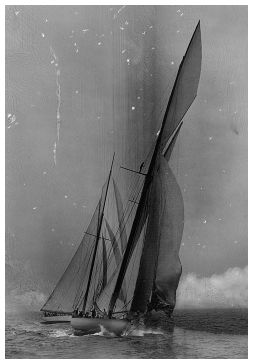 The yachts had started from their moorings in the Horse Shoe early, and when the patrol boats reached the Sandy Hook Lightship were maneuvering for position, darting hither and thither like a pair of giant butterflies, their acres of snowy canvas looming up white and ghostly in the haze.
The yachts had started from their moorings in the Horse Shoe early, and when the patrol boats reached the Sandy Hook Lightship were maneuvering for position, darting hither and thither like a pair of giant butterflies, their acres of snowy canvas looming up white and ghostly in the haze.
Both carried intermediate club topsails in addition to their lower sails and had baby jib topsails up in stops. The preparatory gun boomed out promptly at 10:45, the blue peter fluttered up to the truck of the foremast, and a red ball swung aloft to the spring stay of the committee boat. The race was to be fifteen miles to windward and return, and the easterly wind made the first leg of the course to windward. Both yachts tore through the little heave of sea in exhilarating fashion as they came up to the starting line, both on the starboard tack and with lee rails almost awash.
Shamrock crossed the line at 11:01:03, breaking out her baby jib topsail as she slipped over, a smother of foam under her lee bow, and a cascade of sparkling crystals flying high above the bolt ropes of her headsails. Columbia was on her weather quarter three seconds later in crossing the line, but holding a better position, and also broke out her baby jib topsail. Both were well along on their course before the handicap gun was fired and the starting signals lowered.
In the fine ten-knot breeze that was sweeping across the sea there was no appreciable difference in the set of the sails on either craft. The clubtopsail on the Irish aspirant for international honors was slightly larger than the corresponding sail on the Columbia, and her jib topsail was longer on the luff and broader on the foot than that carried by her rival.
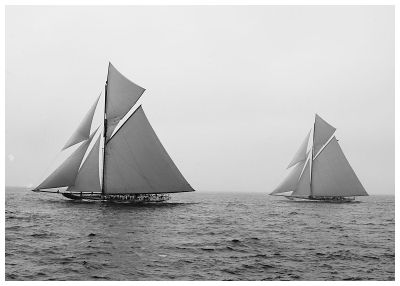 In maneuvering for position at the start Capt. Barr had obtained the weather berth, though slightly astern, and Columbia began to outfoot Shamrock and to eat out to windward of her. Seeing this Capt. Hogarth gave the Shamrock her heels for a time and let her romp off.
In maneuvering for position at the start Capt. Barr had obtained the weather berth, though slightly astern, and Columbia began to outfoot Shamrock and to eat out to windward of her. Seeing this Capt. Hogarth gave the Shamrock her heels for a time and let her romp off.
At 11:16:30 Shamrock went on port tack. Columbia followed immediately, and when the tack was completed Columbia was on Shamrock's weather bow and fully 100 yards dead to windward. Shamrock at once began to romp off again in a vain attempt to get out from under her lee. Columbia kept right on pointing high and footing at her old familiar speed, and it looked as if Shamrock were already beaten.
As soon as Shamrock was out from under Columbia's lee, she luffed up again and pointed well, but the Columbia’s course was 300 yards to windward of that held by the challenger, and both seemed to be traveling at about the same speed.
Shamrocks baby jib topsail was considerably longer on the luff than that of Columbia, and this did not do her any good in the ten-knot breeze. It must have helped to sag her off to leeward and thus prevent her from pointing high. The tack of her club topsail was not set taut, either, and this did not help her any.
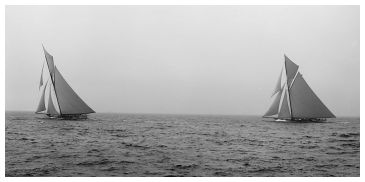 The struggle on this tack was very pretty. Shamrock was constantly ramping off to get out from under her antagonist's lee. As soon as she had succeeded in doing so and got a clear wind again she would luff and hold the same course as Columbia. Then the American yacht would promptly begin to outfoot her, and would crawl up on her weather beam.
The struggle on this tack was very pretty. Shamrock was constantly ramping off to get out from under her antagonist's lee. As soon as she had succeeded in doing so and got a clear wind again she would luff and hold the same course as Columbia. Then the American yacht would promptly begin to outfoot her, and would crawl up on her weather beam.
At 11:32:30 Shamrock went on the starboard tack. Columbia, of course, at once followed suit. It was now plainly to be seen that Columbia was nearly a quarter of a mile dead to windward. Again Shamrock was sailed well off in order to give her plenty of speed.
It seemed to be the only hope of Capt. Hogarth to sail over more ground than Columbia and do it faster. But this is a very hopeless sort of chance in a race to windward, where every inch gained toward the mark even at a slow pace is worth six inches sailed fast but not up toward the wind.
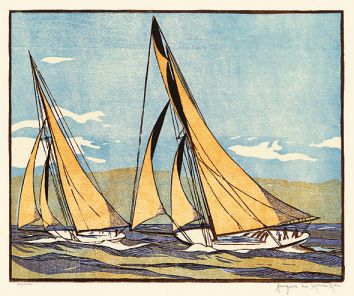 Although the wind had not freshened, but was still blowing a good sailing breeze, Shamrock’s topsail yard was bent far backward above the topmast, and the leech of her club topsail consequently bagged very badly.
Although the wind had not freshened, but was still blowing a good sailing breeze, Shamrock’s topsail yard was bent far backward above the topmast, and the leech of her club topsail consequently bagged very badly.
Capt. Hogarth had now discovered that his tactics of ramping Shamrock off in the hope of footing enough faster than Columbia to enable him to sail around her would not work to the advantage of the Irish yacht, and so he decided to see whether he could not gain something by making use of the challenger’s famous smartness in making short tacks. Her speed in stays had been regarded by her people as something little short of wonderful, and in the three attempts to sail the race in the light airs of last week Columbia had not shown how smart she was at this same business.
At 11:47 Capt. Hogarth made a feint of turning to the port tack but as soon as Shamrock was up in the wind he paid her off on the starboard tack again. Columbia went on the port tack when Shamrock made the feint and it looked for a moment as if the trick of Capt. Hogarth was successful, but the next instant Columbia went back to the starboard tack with a celerity that brought a flush of Joy to the cheeks of every one of her lovers.
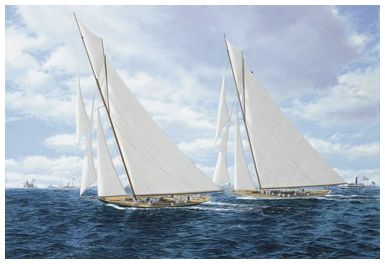 At 11:47:30 Shamrock went on the port tack, this time really, and Columbia at once followed her lead. The challenger did not hold the new board for any length of time, but at 11:50:30 went on the port tack. Columbia held her leg for half a minute longer and followed her antagonist to the port tack. She was now nearly half a mile to windward of the Irish yacht and was apparently still gaining distance.
At 11:47:30 Shamrock went on the port tack, this time really, and Columbia at once followed her lead. The challenger did not hold the new board for any length of time, but at 11:50:30 went on the port tack. Columbia held her leg for half a minute longer and followed her antagonist to the port tack. She was now nearly half a mile to windward of the Irish yacht and was apparently still gaining distance.
At 11:51:30 Shamrock went on the starboard, tack, and in one minute the defender of the cup imitated her example. Columbia now held a commanding position on the weather bow of the challenger. At 11:52:45, just 15 seconds after Columbia's last tack, Shamrock went on the port tack, and at 11:54:45 Columbia followed suit.
About this time it occurred to Capt. Hogarth that he had had enough of this game, for Columbia was doing quite as well as Shamrock in the matter of quickness in stays, and it seemed to be proved that Shamrock’s remarkable superiority in this department of sailing was only in light airs.
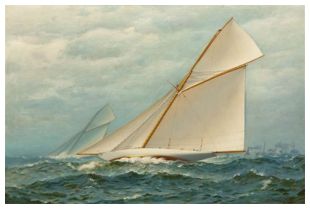 Shamrock now held her port leg for a time, for six minutes she stood on, and then she went on the starboard tack again. Columbia held on for exactly a minute longer and then went about. She was now fully half a mile to windward of her opponent, showing that she had lost nothing in the series of short tacks.
Shamrock now held her port leg for a time, for six minutes she stood on, and then she went on the starboard tack again. Columbia held on for exactly a minute longer and then went about. She was now fully half a mile to windward of her opponent, showing that she had lost nothing in the series of short tacks.
Shamrock now returned to her ramping-off tactics, and as the wind was a little better she gave a pretty exhibition of footing with a fine heel to leeward. It looked as if, she were going through the water faster than Columbia, but, as before, this proved to be a deceptive appearance.
The wind seemed to be freshening a trifle, but the sea was quite smooth yet. There were only a few white caps to be seen, and it was in every way an excellent day for both yachts to show her best qualifies.
The American yacht did not seem to be doing any extraordinary moving, yet she was footing at a very lively pace. She was standing up as well as her opponent, if not better, and as for pointing, there could be no question as to her superiority.
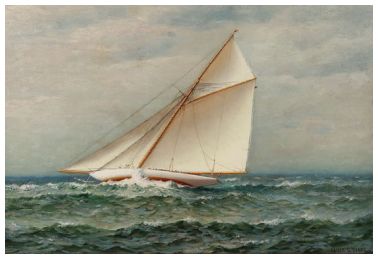 At 12:13 Shamrock went on the port tack, and at 12:13:20 Columbia followed. The American yacht was now fully five-eighths of a mile dead to windward of her opponent. Shamrock went on the starboard tack at 12:26:20, and Columbia immediately followed suit. The American yacht had now an indisputable lead of about two-thirds of a mile to windward.
At 12:13 Shamrock went on the port tack, and at 12:13:20 Columbia followed. The American yacht was now fully five-eighths of a mile dead to windward of her opponent. Shamrock went on the starboard tack at 12:26:20, and Columbia immediately followed suit. The American yacht had now an indisputable lead of about two-thirds of a mile to windward.
Looking along a line crossing their course at right angles it was easy to see that there was a quarter of a mile of open water between the American yacht’s taffrail and Shamrock’s bowsprit. At the same time there was nearly, if not quite, half a mile of water between their two courses.
When she went about Shamrock took in her little jib topsail, Capt. Hogarth apparently believing that it was knocking his yacht off the wind. At 11:35:45 Shamrock went on the port tack again, Columbia at once following. The American yacht was gaining on every tack. Shamrock sent up a little jib topsail after tacking. This was her smallest jib topsail, and she should have had it on from the start.
At 12:46:30 Shamrock went on the port tack, and Columbia at once followed her lead. She held this board only two minutes, and then went on the starboard tack again. Columbia, of course, followed. It would have been very poor policy indeed for the Iselin-Barr combination to split tacks with Shamrock when they had her surely beaten on the windward leg of the course.
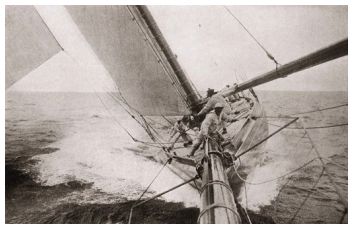 At 12:00:30 Shamrock went on the port tack, and Columbia did the same ten seconds later. It was plain that since the challenger had set her smallest jib topsail she had done much better. She had lost less ground to leeward than at the outset of the race, and she footed quite as fast as she had previously done. She took it in, however, before the tack ended. Columbia had not shifted a sail nor started a sheet since she crossed the line. She went right along about her business, leaving it to her antagonist to try all the experiments. It is always the losing boat that has to work.
At 12:00:30 Shamrock went on the port tack, and Columbia did the same ten seconds later. It was plain that since the challenger had set her smallest jib topsail she had done much better. She had lost less ground to leeward than at the outset of the race, and she footed quite as fast as she had previously done. She took it in, however, before the tack ended. Columbia had not shifted a sail nor started a sheet since she crossed the line. She went right along about her business, leaving it to her antagonist to try all the experiments. It is always the losing boat that has to work.
At 1:06:15 Columbia went on the starboard tack, thus taking the initiative for the first time in the race. This tack was made because the mark boat was in plain sight, and Columbia was in danger of over-standing if she held her port tack and waited for Shamrock. Of course, such an error would have helped the challenger, and Capt. Hogarth naturally hoped Capt. Barr would make it. Finding that Columbia was about, however Shamrock followed suit.
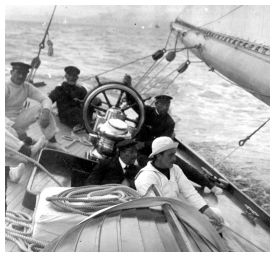 Capt. Hogarth seemed to find the wind a trifle softer again, and he sent up his baby jib topsail once more. Columbia was now fully three-fourths of a mile ahead of the Irish cup hunter, and looked good for seven to eight minutes lead at, the outer mark.
Capt. Hogarth seemed to find the wind a trifle softer again, and he sent up his baby jib topsail once more. Columbia was now fully three-fourths of a mile ahead of the Irish cup hunter, and looked good for seven to eight minutes lead at, the outer mark.
Shamrock was badly pinched for a few seconds. It may have been simply to let her crew get the jib topsail sheet down, as it did not occur again.
At 1:15:20 Columbia went on the port tack, and ten seconds later Shamrock imitated her. The Irish yacht was squeezed for all she was worth now, while Columbia was sailed rap full and kept going beautifully. The wind had fallen a little lighter, and this was of considerable assistance to the challenger. It was still a fair sailing breeze, however, and it kept Columbia moving. Both yachts had been doing about 8 knots through the water, and this speed had now fallen to about 7 knots.
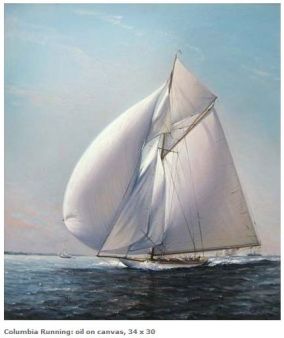 At 1:22:45 Shamrock went on the starboard tack and Columbia at once followed. Long tacks could hardly be expected with the outer mark so near at hand. Shamrock went to the port tack at 1:31:20. Columbia was so much higher to windward that she did not need to follow suit at once, so she kept on her way, heading well up toward the mark. Shamrock’s tack was forced upon her, because she was falling so far to leeward of it.
At 1:22:45 Shamrock went on the starboard tack and Columbia at once followed. Long tacks could hardly be expected with the outer mark so near at hand. Shamrock went to the port tack at 1:31:20. Columbia was so much higher to windward that she did not need to follow suit at once, so she kept on her way, heading well up toward the mark. Shamrock’s tack was forced upon her, because she was falling so far to leeward of it.
At 1:33:30 Shamrock returned to the starboard tack, being then nearly a mile astern of Columbia, and still apparently a little to leeward of her wake. At 1:35:45 Columbia went on the port tack. The mark was about two miles away, and she could not have fetched it on the starboard tack.
At 1:38:40 the defender of America's yachting supremacy went on the starboard tack again. Columbia was now about one mile ahead of Shamrock, and the question of her superiority in windward work in such weather as that of yesterday was settled.
At 1:46:45 Columbia was in a position to fetch the mark on the port tack, and so she went about and stood for it. Just 15 seconds before she made this tack the challenger went on the port tack to make a hitch to the southward so that she could fetch the mark on the next tack, but, as it afterward proved, this hitch was not all she needed.
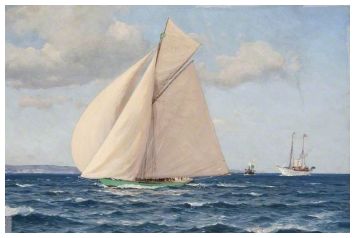 Columbia, having the mark well under her lee, ramped off and with her lee rail nearly awash went for the turning point at railroad speed. She rounded the mark at 1:48:19.
Columbia, having the mark well under her lee, ramped off and with her lee rail nearly awash went for the turning point at railroad speed. She rounded the mark at 1:48:19.
Immediately after Columbia rounded, Shamrock once more wept on the starboard tack, and again at 1:55:15 the challenger went on the port tack, although the mark seemed to be well on her weather bow. She did some elaborate pinching in the desperate attempt to weather the mark on this tack, and finally made two successive half boards before she was able to creep past it by a few yards. Her time at the turn was 1:58:08.
This time shows that Columbia was 9 minutes and 19 seconds ahead of her antagonist at the outer mark. The defender of the cup was 2 hours 47 minutes and 13 seconds in making the beat to the outer mark, while the challenger was 2 hours 57 minutes and 5 seconds in doing it. The American yacht therefore beat her opponent on the windward leg by 9 minutes and 52 seconds.
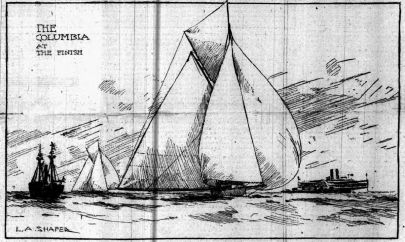 Columbia eased away around the outer mark, leaving it on the starboard hand and lowering her baby jib topsail and breaking out her spinnaker to port, sped away toward the finish line. At 1:56 a balloon jib topsail was broken out, but the wind had grown somewhat lighter, and it failed to fill to its utmost limit for some minutes.
Columbia eased away around the outer mark, leaving it on the starboard hand and lowering her baby jib topsail and breaking out her spinnaker to port, sped away toward the finish line. At 1:56 a balloon jib topsail was broken out, but the wind had grown somewhat lighter, and it failed to fill to its utmost limit for some minutes.
She was fully two miles ahead of the Shamrock when the green boat eased sheets around the mark and set her spinnaker to port in the wake of the white flyer that appeared scarcely more substantial than a wraith in the dim distance. Six minutes after Shamrock rounded the buoy, she set her balloon jib topsail.
At 2:15 the wind, which had softened considerably again, breezed up, holding steady and true from the southeast, and was soon piping merrily at an eight-knot gait. The fog still obscured the leading yacht to some extent, but when the haze lifted at times the white sails of the flyer were visible, but skimming along further and further in advance of the green cutter, until she finally dashed across the winning line amid as perfect pandemonium of shrieks from the brazen throats of half a hundred steam whistles and sirens.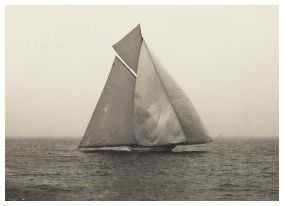
During the latter part of the run to the home mark, the breeze freshened and gave a decided advantage to Shamrock. She was too far off, however, to have even a look-in at the finish, being more than two and a half miles astern of Columbia. Columbia was timed as she crossed the line at 3:54:39, with Shamrock 10 minutes and 11 seconds later.
Headsails were lowered, and the two gladiators were taken in tow by their respective tenders and were escorted inside the Hook, where everything was made snug for the night. Several of the excursion fleet went around into the Horseshoe to permit their passengers a final view of the yachts, but the majority crowded on all steam and steered by the most direct course straight up the Swash Channel.
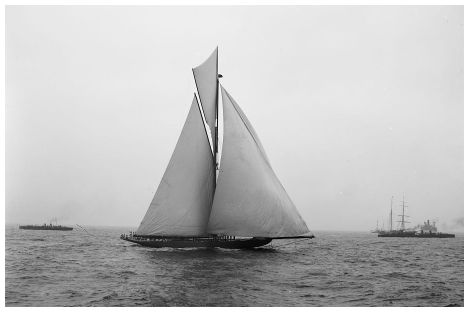 Several impromptu races were decided, none of which was as interesting as the one between the revenue cutters Manning and Gresham, which was won after a fine contest by the first named craft. The leader of the fleet up the bay was Commodore J. Pierpont Morgan's big black flyer Corsair, flagship of the New York Yacht Club, which flung “Old Glory" to the breeze from the trucks of her fore and main, as well as from the taffrail staff.
Several impromptu races were decided, none of which was as interesting as the one between the revenue cutters Manning and Gresham, which was won after a fine contest by the first named craft. The leader of the fleet up the bay was Commodore J. Pierpont Morgan's big black flyer Corsair, flagship of the New York Yacht Club, which flung “Old Glory" to the breeze from the trucks of her fore and main, as well as from the taffrail staff.
Only one passenger boat insisted yesterday on pushing in the line of patrol boats. It was the steel steamer Dolphin, and her pilot was warned several times by a junior revenue officer on a tugboat flying a guard flag. No attention was paid to the warning, and the matter was brought to Capt. Evans's attention.
The Manning sheered alongside the excursion boat, and a few short, pointed sentences from “Fighting Bob” settled the matter quickly, and for the remainder of the day the Dolphin kept at a respectful distance from the line of guard boats.
The summary of the race is as follows:

Columbia won by 10 minutes 8 seconds, corrected time. On the run home Columbia occupied 2 hours 6 minutes 40 seconds, while Shamrock took 2 hours 7 minutes 2 seconds. Columbia gained 22 seconds. Her gain in the first hour and a quarter was at a greater proportion than the figures show, for when the breeze freshened Shamrock made some gain by its aid; and thus lessened Columbia’s lead.
 Publié le 17 0ctobre 1899 |
COLUMBIA LEAVES SHAMROCK BEHIND. |
||
 Publié le 17 0ctobre 1899 |
VICTORY PERCHES ON THE SPEEDY COLUMBIA. |
Page |
Page |
 Publié le 17 Octobre 1899 |
ONE FOR COLUMBIA. |
Page |
Page |
